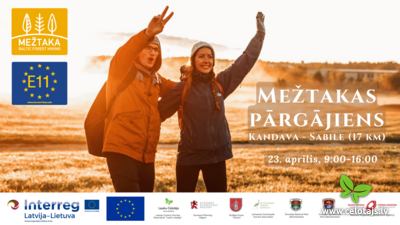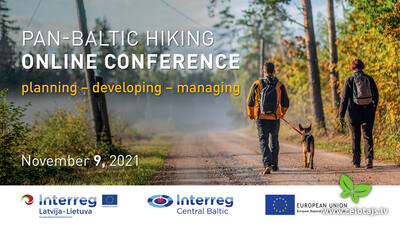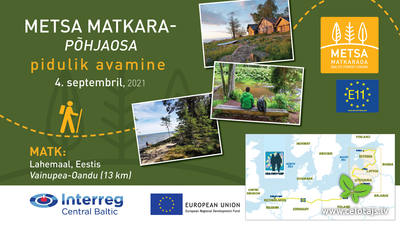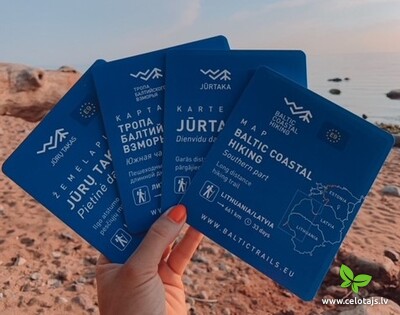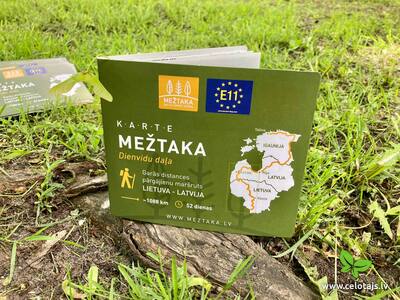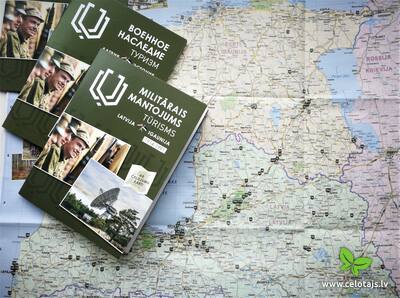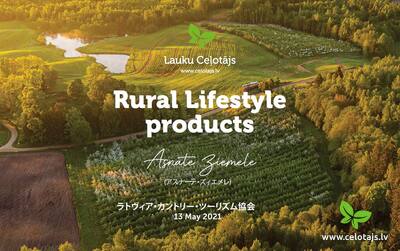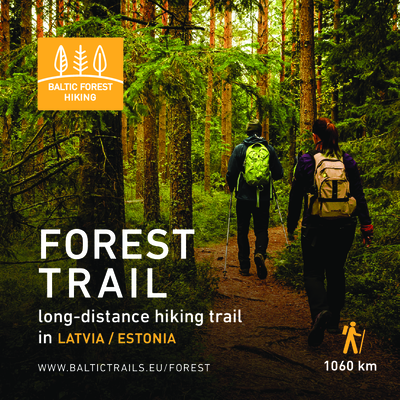Accommodation news
Join our 17 km scenic Forest Trail section #95 from Kandava to Sabile (Zviedru cepure) Spring Hike on April 23. Bring hiking boots, drinking water, spare socks, and remember to dress accordingly to weather. The hike route starts at 9:00 at Ozolaji open-air stage in Kandava (GPS: 57.030567, 22.773616).
Registration >>> ej.uz/springhikingfestival.
Registration for the event closes midnight on the 10th of April or earlier if the maximum number of participants is reached. Participation – free.
The Pan-Baltic hiking online conference on November 9, 2021will celebrate the success of the Baltic Trails (baltictrails.eu) connecting Estonia, Latvia and Lithuania with the European network of hiking paths as part of the routes E9 (Baltic Coastal Hiking) and E11 (Baltic Forest trail).
The conference will bring together stakeholders sharing experiences in planning, implementation, management and maintenance of long distance cross-border hiking trails. The keynote speeches will present experiences from the Baltics, Sweden and Norway. Presentations will be followed by Baltic panel discussions highlighting challenges and solutions in practical aspects such as local acceptance and support, benefits and sustainability of long distance hiking trails.
Please register to receive the conference Zoom link!
>>>The registration is open until 05.11.2021.
>>> Full programme (PDF).
The conference working language is English.
>>> Contacts and information: anna@celotajs.lv.
With a hiking tour on September 4 in Lahemaa national park, Estonia the Forest Trail will be launched as part of E11 long distance hiking path of the European hiking path network. Everybody is welcome to join the 13km opening hike from Vainupea to Oandu villages in Lahemaa national park: Forest Trail section #41.
Tallinn in Estonia is the final destination in the E11 long distance hiking path of the European hiking path network. The E11 route goes: Scheveningen (NL)–Osnabrück (D)–Potsdam (D)–Poznań (PL)–Ogrodniki (PL)–Lazdijai (LIT)–Rīga (LAT)–Tallinn (EST).
Event PROGRAMME and REGISTRATION.
!!!! Only people who can show a COVID-19 certificate will be able to participate or negative test not earlier then 72hours.
Baltic Coastal Hiking is a part of E9 long distance hiking route along the Baltic Sea coast. It starts in Nida resort town, Lithuania, near the border of Lithuania and Russia; crosses Latvia through Rīga and ends in Tallinn, Estonia. This is a map of the Southern Part of the Baltic Coastal Hiking for hikes in Lithuania and Latvia from Nida resort town on the border of Lithuania and Russia to Rīga.
Due to Midsummer holidays and the postponed working day, the office of "Lauku ceļotājs" will be closed from June 23-27. We will work on June 21-22 and then return on June 28. Happy Midsummer!
Kas jāzina un kam jāpievērš uzmanība pirms dodies atpūsties “Zaļajās brīvdienās”? Pēc kādiem kritērijiem atpūtas vietas Latvijā izvēlas trīs bērnu mamma un TV personība Dace Grimze? Ko ģimene iegūst, atpūšoties Latvijas laukos, “Zaļā Sertifikāta” saimniecībās?
Ieskaties https://www.celotajs.lv/zalais.
Materiāls tapis ar Latvijas Vides aizsardzības fonda atbalstu.
The Forest Trail is a part of the European long-distance hiking route E11 in the Baltic States, which leads through the most beautiful forests and national parks. It begins in Lazdijai town near the Lithuanian-Polish border, crosses Lithuania and Latvia, turning into Riga, and ends in Tallinn, Estonia. This is a map of the Forest Trail’s Southern part in Lithuania and Latvia from Lazdijai town near the Lithuanian-Polish border through Kurzeme to Riga.
This summer we are inviting travellers to visit locations where important events in the history of Latvia and Estonia occurred from the beginning of World War I and up to the declaration of the two countries' independence in 1918, and then onward to the restoration of their independence in 1990/1991. More than 300 destinations in Latvia and Estonia relate to military heritage - museums, fortifications, military equipment, trails, bunkers, battle sites, military towns, infrastructure and memorial sites.
Šodien, 13. maijā, "Lauku ceļotājs" piedalījās Latvijas Republikas vēstniecības Japānā rīkotajā vebinārā tiešsaistē, kur iepazīstināja japāņu tūroperatorus un medijus ar projektu "Lauku dzīvesveids – Pievilcīgu lauku dzīvesveida galamērķu radīšana" un "Lauku dzīvesveida" produktiem Latvijā.
On December 11, 2020, the winners of the competition "New Tourism Product 2020" in Latvia organized by the Investment and Development Agency of Latvia (LIAA) were announced. The first place was awarded to the tourism product nominated by Vidzeme Planning Region – the long-distance hiking route Forest Trail (Baltic Forest Hiking).
